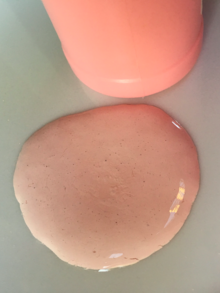An emulsion is a mixture of two or more liquids that are normally immiscible owing to liquid-liquid phase separation. Emulsions are part of a more general class of two-phase systems of matter called colloids. Although the terms colloid and emulsion are sometimes used interchangeably, emulsion should be used when both phases, dispersed and continuous, are liquids. In an emulsion, one liquid is dispersed in the other. Examples of emulsions include vinaigrettes, homogenized milk, liquid biomolecular condensates, and some cutting fluids for metal working.

Cosmetics are constituted mixtures of chemical compounds derived from either natural sources, or synthetically created ones. Cosmetics have various purposes. Those designed for personal care and skin care can be used to cleanse or protect the body or skin. Cosmetics designed to enhance or alter one's appearance (makeup) can be used to conceal blemishes, enhance one's natural features, add color to a person's face, or change the appearance of the face entirely to resemble a different person, creature or object. Due to the harsh ingredients in makeup products, individuals with acne-prone skin are more likely to suffer from breakouts. Cosmetics can also be designed to add fragrance to the body.

Petroleum jelly, petrolatum, white petrolatum, soft paraffin, or multi-hydrocarbon, CAS number 8009-03-8, is a semi-solid mixture of hydrocarbons, originally promoted as a topical ointment for its healing properties. Vaseline has been an American brand of petroleum jelly since 1870.
A humectant is a hygroscopic (water-absorbing) substance used to keep things moist. They are used in many products, including food, cosmetics, medicines and pesticides. When used as a food additive, a humectant has the effect of keeping moisture in the food. Humectants are sometimes used as a component of antistatic coatings for plastics.

A topical medication is a medication that is applied to a particular place on or in the body. Most often topical medication means application to body surfaces such as the skin or mucous membranes to treat ailments via a large range of classes including creams, foams, gels, lotions, and ointments. Many topical medications are epicutaneous, meaning that they are applied directly to the skin. Topical medications may also be inhalational, such as asthma medications, or applied to the surface of tissues other than the skin, such as eye drops applied to the conjunctiva, or ear drops placed in the ear, or medications applied to the surface of a tooth. The word topical derives from Greek τοπικόςtopikos, "of a place".

A moisturizer, or emollient, is a cosmetic preparation used for protecting, moisturizing, and lubricating the skin. These functions are normally performed by sebum produced by healthy skin. The word "emollient" is derived from the Latin verb mollire, to soften.

Desonide (INN) is a low-potency topical corticosteroid anti-inflammatory that has been available since the 1970s. It is primarily used to treat atopic dermatitis (eczema), seborrheic dermatitis, contact dermatitis and psoriasis in both adults and children. It has a fairly good safety profile and is available as a cream, ointment, lotion, and as a foam under the tradename Verdeso Foam. Other trade names for creams, lotions, and ointments include Tridesilon, DesOwen, Desonate. It is a group VI corticosteroid under US classification, the second least potent group.
Natural skin care uses topical creams and lotions made of ingredients available in nature. Much of the recent literature reviews plant-derived ingredients, which may include herbs, roots, flowers and essential oils, but natural substances in skin care products include animal-derived products such as beeswax, and minerals. These substances may be combined with various carrier agents, preservatives, surfactants, humectants and emulsifiers.

Carboxymethyl cellulose (CMC) or cellulose gum is a cellulose derivative with carboxymethyl groups (-CH2-COOH) bound to some of the hydroxyl groups of the glucopyranose monomers that make up the cellulose backbone. It is often used as its sodium salt, sodium carboxymethyl cellulose. It used to be marketed under the name Tylose, a registered trademark of SE Tylose.

A cream is a preparation usually for application to the skin. Creams for application to mucous membranes such as those of the rectum or vagina are also used. Creams may be considered pharmaceutical products, since even cosmetic creams are manufactured using techniques developed by pharmacy and unmedicated creams are highly used in a variety of skin conditions (dermatoses). The use of the finger tip unit concept may be helpful in guiding how much topical cream is required to cover different areas.

Allergic contact dermatitis (ACD) is a form of contact dermatitis that is the manifestation of an allergic response caused by contact with a substance; the other type being irritant contact dermatitis (ICD).
Skin care or skincare is a range of practices that support skin integrity, enhance its appearance, and relieve skin conditions. They can include nutrition, avoidance of excessive sun exposure, and appropriate use of emollients. Practices that enhance appearance include the use of cosmetics, botulinum, exfoliation, fillers, laser resurfacing, microdermabrasion, peels, retinol therapy, and ultrasonic skin treatment. Skin care is a routine daily procedure in many settings, such as skin that is either too dry or too moist, and prevention of dermatitis and prevention of skin injuries.

Amcinonide is a topical glucocorticoid used to treat itching, redness and swelling associated with several dermatologic conditions such as atopic dermatitis and allergic contact dermatitis. Amcinonide can also be classified as a multi-functional small molecule corticosteroid, which has been approved by the FDA and is currently marketed as an ointment, lotion, or cream. It acts as both a transcription factor for responses to glucocorticoids and modulator for other transcription factors while also regulating phospholipase A2 activity.
Personal care products are consumer products which are applied on various external parts of the body such as skin, hair, nails, lips, external genital and anal areas, as well as teeth and mucous membrane of the oral cavity, in order to make them clean, protect them from harmful germs and keep them in good condition. They promote personal hygiene and overall health, well-being and appearance of those body parts. Toiletries form a narrower category of personal care products which are used for basic hygiene and cleanliness as a part of a daily routine. Cosmetic products, in contrast, are used for personal grooming and beautification. Pharmaceutical products are not considered personal care products.
Eyelid dermatitis is commonly related to atopic dermatitis or allergic contact dermatitis. Volatile substances, tosylamide, epoxy hardeners, insect sprays, and lemon peel oil may be implicated, with many cases of eyelid contact dermatitis being caused by substances transferred by the hands to the eyelids.
A barrier cream is a topical formulation used in industrial applications and as a cosmetic to place a physical barrier between the skin and contaminants that may irritate the skin. There are many other terms for creams designed to protect skin from harmful substances, including skin protective creams, pre-work creams, antisolvent gels, protective ointments, and shielding lotions. Three classes of barrier creams are used: water repellent creams, water-soluble creams, and creams designed for special applications. Barrier creams may contain substances such as zinc oxide, talc or kaolin to layer over the skin. For hand care they are designed to protect against the harm from detergents and other irritants.
Infantile acne is a form of acneiform eruption that occurs in infants from 6 weeks to 1 year of age. Typical symptoms include inflammatory and noninflammatory lesions, papules and pustules most commonly present on the face. No cause of infantile acne has been established but it may be caused by increased sebaceous gland secretions due to elevated androgens, genetics and the fetal adrenal gland causing increased sebum production. Infantile acne can resolve by itself by age 1 or 2. However, treatment options include topical benzyl peroxide, topical retinoids and topical antibiotics in most cases.

Aquaphor is a brand of over-the-counter (OTC) skin care ointments manufactured by Beiersdorf Inc., an affiliate of Beiersdorf AG. Aquaphor is offered in four product ranges: There are two skin protectant ointments. Aquaphor Original Ointment, used as a compounding agent and Aquaphor Advanced Therapy Healing Ointment, sold in mass retail outlets. The other product ranges include: Aquaphor Lip Repair and Lip Repair + Protect SPF 30, and Aquaphor Baby.

Topical cream formulation is an emulsion semisolid dosage form that is used for skin external application. Most of the topical cream formulations contain more than 20 per cent of water and volatiles and/or less than 50 per cent of hydrocarbons, waxes, or polyethylene glycols as the vehicle for external skin application. In a topical cream formulation, ingredients are dissolved or dispersed in either a water-in-oil (W/O) emulsion or an oil-in-water (O/W) emulsion. The topical cream formulation has a higher content of oily substance than gel, but a lower content of oily ingredient than ointment. Therefore, the viscosity of topical cream formulation lies between gel and ointment. The pharmacological effect of the topical cream formulation is confined to the skin surface or within the skin. Topical cream formulation penetrates through the skin by transcellular route, intercellular route, or trans-appendageal route. Topical cream formulation is used for a wide range of diseases and conditions, including atopic dermatitis (eczema), psoriasis, skin infection, acne, and wart. Excipients found in a topical cream formulation include thickeners, emulsifying agents, preservatives, antioxidants, and buffer agents. Steps required to manufacture a topical cream formulation include excipient dissolution, phase mixing, introduction of active substances, and homogenization of the product mixture.
Horse ointment, known as horse oil and horse fat, is a topical formulation derived from subcutaneous fat of horses. With its thick and highly viscous properties, horse ointment is intended for topical use on human skin and mucous membranes to provide moisturization and boost the restoration of damaged skin. Horse ointment preparations was traditionally used in ancient China for the treatment of qi deficiency, haemorrhoids, burns and xeroderma. Due to a high proportion of fatty acids in horse ointment, which are similar to human skin fat, it can effectively penetrate through the skin surface. Nowadays, it is commonly applied to skin for the purpose of soothing redness and irritation. It is considered a natural skincare product with low risks of sensitization and irritation and is safe for people of all ages, including infants and seniors.

















